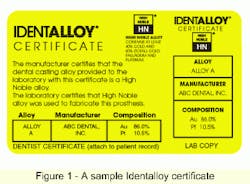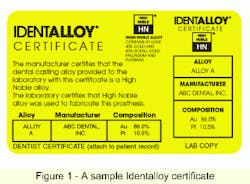Protection for you... Peace of mind for patients
by Bruce Bloom, DDS, JD
I've taught risk management and practice management to thousands of dentists over the last 20 years. Dental professionals are eager to use risk management tools that improve patient care. They rightly complain, however, that implementation costs too much and takes too long, while the benefits are difficult to pinpoint.
The cost-benefit issues of risk management are very real, so when I came upon a tool with obvious patient-care benefits, yet carries no additional cost and takes no additional time, I had to let my colleagues know about it.
The Identalloy program's benefits are numerous :
- Free - Someone else pays for it.
- Easy - A color-coded, self-adhesive sticker goes right in the patient record.
- Quick - The sticker is automatically sent with each completed prosthetic case.
- Widely available - 90 percent of all precious metals used in dental prostheses are registered with the Identalloy program and carry an Identalloy certificate.
- Enhanced quality of care - Provides independent documentation and certification of material composition.
- Improved risk management - A great informed consent and record- keeping tool.
- Liability transfer - Another party guarantees its accuracy and validity.
The program
The Identalloy program is an independent materials documentation and classification program that upholds the strict standards for dental alloy composition established by the American Dental Association. The program provides dental laboratories and clinicians with the name, manufacturer, and content of alloys used in their restorations. It enhances education, record keeping, and the overall quality of restorative dental care.
Progressive dental manufacturers, who understood the need to regulate the explosive growth in new restorative materials, created the Identalloy program in 1986. As restorative dentistry expanded, the number and types of alloys and other restorative materials increased; so did the choices for both dental laboratories and dentists. The major alloy manufacturers agreed that standardization of materials and claims would enable users to make more educated choices about materials. Working in partnership with the ADA, manufacturers created specific alloy classification categories; they then formed the Identalloy Council to implement these guidelines. The council leadership includes manufacturers, laboratories, and dentists.
Adopting easily recognizable alloy composition symbols, the Identalloy Council began operations, issuing its now-familiar High Noble, Noble, and Predominantly Base Identalloy certificates to acceptable alloys (see Figure 2).
Each alloy in the Identalloy program carries an identification symbol noting the specific alloy category as established by the ADA Council on Dental Materials, Instruments, and Equipment. These categories reflect the differences in composition of the restorative materials.
Only alloys in the Identalloy program are permitted to use these symbols. Identalloy stickers identify the company, brand name, and composition. They are color-coded for quick identification and include the recognizable alloy symbol for proper insurance coding (see sample certificate in Figure 1).
Risk-management benefits
Securing and updating a patient's medical and dental history has a multitude of risk management benefits. One area dentists concentrate on is allergies; many materials and pharmaceuticals used in our profession can elicit reactions, including the base metals in alloys used for restorative care.
The first step to maximizing the benefits of the Identalloy program is to include questions about material allergies on patient medical histories. The second step is to document the allergies your patients have.
The third step is to choose alloys that do not contain metals to which patients are allergic. The final - and most important - step is to document that you have used such alloys with the Identalloy program.
Informed consent
No care should be undertaken without the patient's informed consent. To obtain informed consent, a dentist must first provide sufficient information. There are three parts to every informed consent discussion:
- Necessity of treatment
- Alternative treatments
- Treatment risks
Necessity of treatment. The dentist must educate the patient about what treatment is recommended, and why. The dentist also must educate the patient about which materials are available, including cast or laboratory-made restorations vs. chairside restorations. A dentist who using the Identalloy system will have more information to share and more visual aids to assist in this process.
Alternative treatments. The patient must always have a choice of treatments. For many, a wide variety of materials is appropriate. When you are trying to help patients decide between cast restoration materials, the Identalloy stickers can help them understand the differences in cost and selection of metals.
Treatment risks. During the informed-consent discussion, dentists must educate patients about the risks. For patients who are allergic to certain alloys or metals, the knowledge Identalloy provides can be a lifesaver. For those patients unsure about their allergies or who have other issues involving certain metals, the valuable information Identalloy provides assists with the decision-making process.
Another risk that should be discussed with the patient is the chance of galvanic reaction. Dentists who use this system can accurately determine the presence and concentration of metals in a restoration; they can therefore predict with greater certainty the likelihood of galvanic reaction with a new restoration, whether cast or chairside.
Other benefits
Informed-consent documentation. The choice of restorative materials should be documented in the patient's record as part of the informed consent discussion. Once you have received the Identalloy sticker with the completed case and attached it to the record, you have completed the informed-consent circle: discussion, documentation, and verification.
Staff training and awareness. If you want to attract and retain quality staff, you must exude quality yourself. The difference between the appearance of quality and the appearance of indifference is subtle. The implementation of the Identalloy system is one of those subtle quality statements. Dentists who use this system indicate that they care enough to go the extra mile to educate patients and to document their care. The staff is affected by these subtleties. This subtle gesture is easy and costs nothing!
Quality of patient care. Patients rarely judge the quality of their care by checking the margins of their restorations or determining how it fits into their occlusion. Patients judge quality by the cleanliness of the office, how they are treated by the dentist and staff, the efficiency of the services provided, and the accuracy of the information they receive.
Patients depend on dentists and their staff to guarantee they receive quality care; they know that dentists have the training, expertise, and knowledge to utilize the best tools. In short, they expect their dentists to implement a system like this one.
Choosing a lab. Patients expect their dentists to ensure a high quality of care; dentists expect the dental laboratory to do the same. We judge labs by how they manage the cases sent to them. We also evaluate lab integrity on an ongoing basis and constantly monitor the value they give. We also expect labs to do those little things that assist us in protecting the patient. Identalloy is one of those "little things." Dental laboratories that use this system are stating, "We go the extra step to help you ensure better patient care."
Manufacturers. Many materials manufacturers voluntarily participate in the Identalloy program. They do it as a service to you, your patients, and to dental laboratories. Your peers at the ADA determined the standards they follow. Manufacturers who participate support your efforts to improve the quality of patient care.
Insurance submissions. The use of Identalloy can improve the timeliness and accuracy of insurance submissions. Insurance companies delay payments for many restorative procedures while they investigate which materials were used. A photocopy of the Identalloy sticker can be sent with a completed case to reduce the need for inquiries. In addition, a copy of the sticker can be sent with a pre-estimate to help expedite prior approval.
Standard of care. Every dentist must practice up to the "standard of care." This standard is defined as that which any reasonable dentist would do under the same or similar circumstances. The use of the Identalloy program does not guarantee that a patient won't suffer an untoward incident related to restorative materials; however, it is a strong indicator that the dentist is doing everything possible to meet or exceed the accepted standard of care.
Transfer of liability. What if a patient does suffer an injury in your office related to the use of certain metals in cast dental restorations? If the injury is due to the mislabeling of the Identalloy sticker, the liability belongs to the printer or sticker distributor, rather than the dentist.
If the injury is due to the use of the wrong alloy by the lab, the liability in most instances is theirs. The dentist may still be a target of litigation, but the use of the Identalloy program helps limit the chance of loss.
Rules for participation in the Identalloy program are simple, but strict. Manufacturers wishing to participate in the program must supply documentation that they voluntarily abide by the ADA-sanctioned guidelines determining alloy content. High noble alloys have to be at least 60 percent noble metal, with 40 percent gold. Noble alloys have to contain at least 25 percent noble metal.
As each alloy is accepted into the program, the manufacturer is presented with custom Identalloy certificate stickers to include with each shipment. Each sticker features the brand name, manufacturer's name, alloy composition, and, most importantly, the classification. The certificates are provided as permanent records of alloy documentation to all dental laboratories and dental offices using the alloys.
The immediate response to the Identalloy program has been overwhelmingly positive. Dr. Gordon Christensen's venerable CRA Newsletter rated the Identalloy program as "Excellent." The National Association of Dental Laboratories, Dental Laboratory Conference, and Health Insurance Institute of America likewise endorse the program.
Today, this independent certification system continues to provide the only commercial oversight of restorative materials, distributing value-added educational and record-keeping services free of charge to dental laboratories and practices. Approximately 90 percent of the precious metal alloys used in the U.S. are registered with the Identalloy program and carry Identalloy certificates.
The widespread success and acceptance for the classification and documentation of precious metal alloys has spurred the Identalloy program to expand its scope to deliver the proven benefits of material documentation to all restorative materials. The expansion of this program will enhance an already great risk-management and practice-management tool for the dentist.

